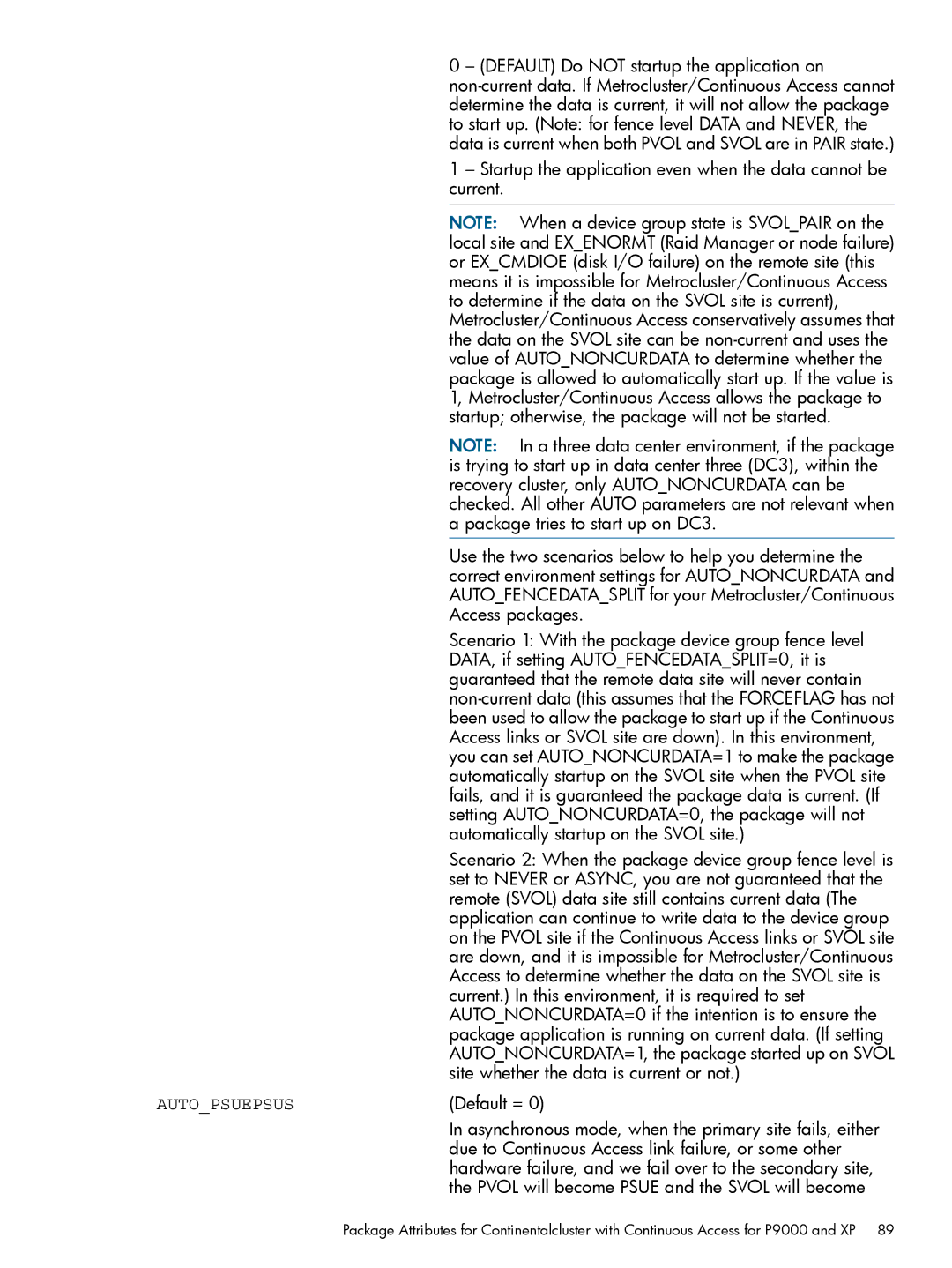
| 0 – (DEFAULT) Do NOT startup the application on |
| |
| determine the data is current, it will not allow the package |
| to start up. (Note: for fence level DATA and NEVER, the |
| data is current when both PVOL and SVOL are in PAIR state.) |
| 1 – Startup the application even when the data cannot be |
| current. |
| NOTE: When a device group state is SVOL_PAIR on the |
| local site and EX_ENORMT (Raid Manager or node failure) |
| or EX_CMDIOE (disk I/O failure) on the remote site (this |
| means it is impossible for Metrocluster/Continuous Access |
| to determine if the data on the SVOL site is current), |
| Metrocluster/Continuous Access conservatively assumes that |
| the data on the SVOL site can be |
| value of AUTO_NONCURDATA to determine whether the |
| package is allowed to automatically start up. If the value is |
| 1, Metrocluster/Continuous Access allows the package to |
| startup; otherwise, the package will not be started. |
| NOTE: In a three data center environment, if the package |
| is trying to start up in data center three (DC3), within the |
| recovery cluster, only AUTO_NONCURDATA can be |
| checked. All other AUTO parameters are not relevant when |
| a package tries to start up on DC3. |
| Use the two scenarios below to help you determine the |
| correct environment settings for AUTO_NONCURDATA and |
| AUTO_FENCEDATA_SPLIT for your Metrocluster/Continuous |
| Access packages. |
| Scenario 1: With the package device group fence level |
| DATA, if setting AUTO_FENCEDATA_SPLIT=0, it is |
| guaranteed that the remote data site will never contain |
| |
| been used to allow the package to start up if the Continuous |
| Access links or SVOL site are down). In this environment, |
| you can set AUTO_NONCURDATA=1 to make the package |
| automatically startup on the SVOL site when the PVOL site |
| fails, and it is guaranteed the package data is current. (If |
| setting AUTO_NONCURDATA=0, the package will not |
| automatically startup on the SVOL site.) |
| Scenario 2: When the package device group fence level is |
| set to NEVER or ASYNC, you are not guaranteed that the |
| remote (SVOL) data site still contains current data (The |
| application can continue to write data to the device group |
| on the PVOL site if the Continuous Access links or SVOL site |
| are down, and it is impossible for Metrocluster/Continuous |
| Access to determine whether the data on the SVOL site is |
| current.) In this environment, it is required to set |
| AUTO_NONCURDATA=0 if the intention is to ensure the |
| package application is running on current data. (If setting |
| AUTO_NONCURDATA=1, the package started up on SVOL |
| site whether the data is current or not.) |
AUTO_PSUEPSUS | (Default = 0) |
| In asynchronous mode, when the primary site fails, either |
| due to Continuous Access link failure, or some other |
| hardware failure, and we fail over to the secondary site, |
| the PVOL will become PSUE and the SVOL will become |
Package Attributes for Continentalcluster with Continuous Access for P9000 and XP 89
